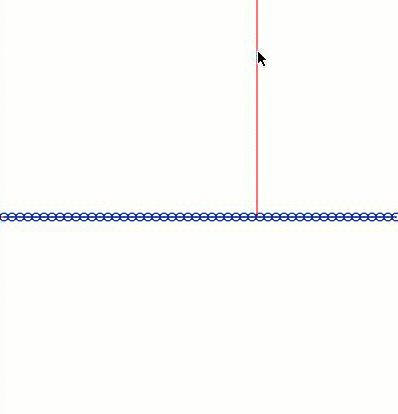Ich versuchte es.
Spritzer (Federn)
Wie in diesem Tutorial erwähnt, ist die Wasseroberfläche wie ein Draht: Wenn Sie an einem Punkt des Drahtes ziehen, werden die Punkte neben diesem Punkt ebenfalls nach unten gezogen. Alle Punkte werden auch auf eine Grundlinie zurückgeführt.
Es sind im Grunde viele vertikale Federn nebeneinander, die sich auch gegenseitig anziehen.
Ich habe das in Lua mit LÖVE skizziert und folgendes bekommen:

Sieht plausibel aus. Oh Hooke , du hübsches Genie.
Wenn Sie damit spielen möchten, ist hier ein JavaScript-Port von Phil ! Mein Code ist am Ende dieser Antwort.
Hintergrundwellen (gestapelte Sinus)
Natürliche Hintergrundwellen sehen für mich aus wie ein Bündel von Sinuswellen (mit unterschiedlichen Amplituden, Phasen und Wellenlängen), die alle zusammen addiert werden. So sah das aus, als ich es schrieb:

Die Interferenzmuster sehen ziemlich plausibel aus.
Jetzt alle zusammen
Dann ist es ziemlich einfach, die Splash-Wellen und die Hintergrundwellen zusammenzufassen:

Wenn Spritzer auftreten, können Sie kleine graue Kreise sehen, die anzeigen, wo sich die ursprüngliche Hintergrundwelle befinden würde.
Es sieht dem Video, das Sie verlinkt haben , sehr ähnlich , daher würde ich dies als ein erfolgreiches Experiment betrachten.
Hier ist meine main.lua(die einzige Datei). Ich denke es ist ziemlich lesbar.
-- Resolution of simulation
NUM_POINTS = 50
-- Width of simulation
WIDTH = 400
-- Spring constant for forces applied by adjacent points
SPRING_CONSTANT = 0.005
-- Sprint constant for force applied to baseline
SPRING_CONSTANT_BASELINE = 0.005
-- Vertical draw offset of simulation
Y_OFFSET = 300
-- Damping to apply to speed changes
DAMPING = 0.98
-- Number of iterations of point-influences-point to do on wave per step
-- (this makes the waves animate faster)
ITERATIONS = 5
-- Make points to go on the wave
function makeWavePoints(numPoints)
local t = {}
for n = 1,numPoints do
-- This represents a point on the wave
local newPoint = {
x = n / numPoints * WIDTH,
y = Y_OFFSET,
spd = {y=0}, -- speed with vertical component zero
mass = 1
}
t[n] = newPoint
end
return t
end
-- A phase difference to apply to each sine
offset = 0
NUM_BACKGROUND_WAVES = 7
BACKGROUND_WAVE_MAX_HEIGHT = 5
BACKGROUND_WAVE_COMPRESSION = 1/5
-- Amounts by which a particular sine is offset
sineOffsets = {}
-- Amounts by which a particular sine is amplified
sineAmplitudes = {}
-- Amounts by which a particular sine is stretched
sineStretches = {}
-- Amounts by which a particular sine's offset is multiplied
offsetStretches = {}
-- Set each sine's values to a reasonable random value
for i=1,NUM_BACKGROUND_WAVES do
table.insert(sineOffsets, -1 + 2*math.random())
table.insert(sineAmplitudes, math.random()*BACKGROUND_WAVE_MAX_HEIGHT)
table.insert(sineStretches, math.random()*BACKGROUND_WAVE_COMPRESSION)
table.insert(offsetStretches, math.random()*BACKGROUND_WAVE_COMPRESSION)
end
-- This function sums together the sines generated above,
-- given an input value x
function overlapSines(x)
local result = 0
for i=1,NUM_BACKGROUND_WAVES do
result = result
+ sineOffsets[i]
+ sineAmplitudes[i] * math.sin(
x * sineStretches[i] + offset * offsetStretches[i])
end
return result
end
wavePoints = makeWavePoints(NUM_POINTS)
-- Update the positions of each wave point
function updateWavePoints(points, dt)
for i=1,ITERATIONS do
for n,p in ipairs(points) do
-- force to apply to this point
local force = 0
-- forces caused by the point immediately to the left or the right
local forceFromLeft, forceFromRight
if n == 1 then -- wrap to left-to-right
local dy = points[# points].y - p.y
forceFromLeft = SPRING_CONSTANT * dy
else -- normally
local dy = points[n-1].y - p.y
forceFromLeft = SPRING_CONSTANT * dy
end
if n == # points then -- wrap to right-to-left
local dy = points[1].y - p.y
forceFromRight = SPRING_CONSTANT * dy
else -- normally
local dy = points[n+1].y - p.y
forceFromRight = SPRING_CONSTANT * dy
end
-- Also apply force toward the baseline
local dy = Y_OFFSET - p.y
forceToBaseline = SPRING_CONSTANT_BASELINE * dy
-- Sum up forces
force = force + forceFromLeft
force = force + forceFromRight
force = force + forceToBaseline
-- Calculate acceleration
local acceleration = force / p.mass
-- Apply acceleration (with damping)
p.spd.y = DAMPING * p.spd.y + acceleration
-- Apply speed
p.y = p.y + p.spd.y
end
end
end
-- Callback when updating
function love.update(dt)
if love.keyboard.isDown"k" then
offset = offset + 1
end
-- On click: Pick nearest point to mouse position
if love.mouse.isDown("l") then
local mouseX, mouseY = love.mouse.getPosition()
local closestPoint = nil
local closestDistance = nil
for _,p in ipairs(wavePoints) do
local distance = math.abs(mouseX-p.x)
if closestDistance == nil then
closestPoint = p
closestDistance = distance
else
if distance <= closestDistance then
closestPoint = p
closestDistance = distance
end
end
end
closestPoint.y = love.mouse.getY()
end
-- Update positions of points
updateWavePoints(wavePoints, dt)
end
local circle = love.graphics.circle
local line = love.graphics.line
local color = love.graphics.setColor
love.graphics.setBackgroundColor(0xff,0xff,0xff)
-- Callback for drawing
function love.draw(dt)
-- Draw baseline
color(0xff,0x33,0x33)
line(0, Y_OFFSET, WIDTH, Y_OFFSET)
-- Draw "drop line" from cursor
local mouseX, mouseY = love.mouse.getPosition()
line(mouseX, 0, mouseX, Y_OFFSET)
-- Draw click indicator
if love.mouse.isDown"l" then
love.graphics.circle("line", mouseX, mouseY, 20)
end
-- Draw overlap wave animation indicator
if love.keyboard.isDown "k" then
love.graphics.print("Overlap waves PLAY", 10, Y_OFFSET+50)
else
love.graphics.print("Overlap waves PAUSED", 10, Y_OFFSET+50)
end
-- Draw points and line
for n,p in ipairs(wavePoints) do
-- Draw little grey circles for overlap waves
color(0xaa,0xaa,0xbb)
circle("line", p.x, Y_OFFSET + overlapSines(p.x), 2)
-- Draw blue circles for final wave
color(0x00,0x33,0xbb)
circle("line", p.x, p.y + overlapSines(p.x), 4)
-- Draw lines between circles
if n == 1 then
else
local leftPoint = wavePoints[n-1]
line(leftPoint.x, leftPoint.y + overlapSines(leftPoint.x), p.x, p.y + overlapSines(p.x))
end
end
end



